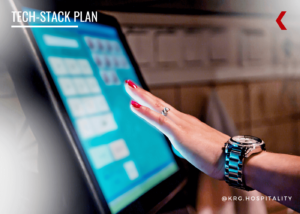What are You Changing in Your Restaurant or Bar in 2024?
by David Klemt

More fun with AI-generated images. That’s quite the busy bar setup.
Toward the end of last year, Nation’s Restaurant News identified what changes operators chose to make after analyzing their operational data.
The publication surveyed hundreds of operators about how data drove their decisions. This survey was an element of their year-end report, Market Leader Report: The Data-driven Restaurant.
As one would imagine, this report focuses on data collection, analysis, and usage. However, NRN‘s report doesn’t just address the importance of data collection in the F&B space. Rather, they seek to understand if operators are collecting the “right” data; whether they can optimize the data they collect; what metrics they’re tracking; and how they’re acting on all that data.
Simply put, it’s an important report addressing a topic crucial to today’s restaurant and bar operations. Those who want their own copy of The Data-driven Restaurant can download it free here.
While entire report is valuable, the focus of this article is one question and the answers provided. Below, to provide context, is a breakdown of the survey respondents.
The Who
Most of the respondents identified as independent restaurant operators.
- Indie: 37 percent
- Chain (franchisee): 21 percent
- Chain (company owned): 18 percent
- Multi-concept: 15 percent
- Single-site operator: 6 percent
- HQ or brand level of foodservice company: 3 percent
By a slim margin, most survey respondents categorized their restaurants as full service or casual dining.
Perhaps unsurprisingly, the fewest respondents operate in the upscale or fine dining category.
- Full service / casual dining: 30 percent
- Fast casual: 28 percent
- Quick service: 20 percent
- Midscale / family dining: 15 percent
- Upscale / fine dining: 7 percent
The What
So, what question caught our attention at KRG Hospitality?
“In the past 12 months, which initiatives did your organization undertake after analyzing data?”
NRN conducted this survey in November 2023. Not surprisingly, respondents mostly made changes to their menus after reviewing their data. Streamlining menus and adjusting prices were two of the biggest operational trends last year, as many operators are no doubt well aware.
That theory is supported by the survey results. Below, the top four answers to the question above.
- Changed menu prices (48 percent)
- Removed items from or added items to our menu (47 percent)
- Improved the way we trained our staff (26 percent)
- Adjusted our loyalty program’s rewards and/or incentives (24 percent)
Honestly, it’s heartening to see that training is among the top-three data-driven actions operators took last year. And, of course, it’s not shocking that the menu was the focus of the most attention. Streamlining is an effective way to reduce food and labor costs. Further, pricing is always (please excuse the pun) on the menu.
Our question is: What changes, if any, do you plan to implement this year now that we’re headed into Q3?
The What: The Sequel
If the menu received the most attention after operators reviewed their data, what received the least?
Well, it appears marketing fell to the wayside, along with the kitchen. The following are the bottom four answers to the question in the section above:
- A/B tested marketing campaigns and increased ROI (6 percent)
- Changed specs on our kitchen equipment or technology (10 percent)
- Identified lapsed customers and marketed to them (11 percent)
- Increased throughput in our kitchen during peak periods (13 percent)
Now, I’ll concede that one marketing action found itself in the middle of the pack when it came to this survey question. Upon analyzing their data, 18 percent of respondents identified new potential guests and marketed to those people.
Still, in comparison to making changes to menus, the fewest respondents took marketing action or made changes to the kitchen directly.
Does this mean that menu changes have the greatest impact on guests and ROI? Well, that’s possible. However, I think something else is at play.
Personally, I think collecting data is the easy part. At this point, most platforms serving our industry are collecting data for operators.
But tracking the correct metrics, analyzing the associated data, and knowing what to do after analyzing said data? That’s difficult. It can be overwhelming, which is why it’s so important to build and implement the proper tech stack for a specific concept. This is why one of the services we offer our clients is tech-stack development.
Further, the tech stack needs to be built around an operator and their leadership team. If nobody knows how to use it or what to do with the data they’re collecting, it’s useless.
Image: Shutterstock. Disclaimer: This image was generated by an Artificial Intelligence (AI) system.

